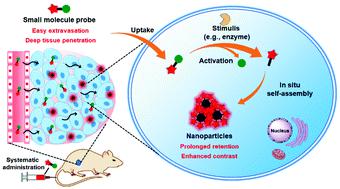当前位置:
X-MOL 学术
›
Biomater. Sci.
›
论文详情
Our official English website, www.x-mol.net, welcomes your
feedback! (Note: you will need to create a separate account there.)
Recent advances in stimuli-responsive in situ self-assembly of small molecule probes for in vivo imaging of enzymatic activity.
Biomaterials Science ( IF 5.8 ) Pub Date : 2020-06-23 , DOI: 10.1039/d0bm00895h Yuqi Wang 1 , Jianhui Weng , Xidan Wen , Yuxuan Hu , Deju Ye
Biomaterials Science ( IF 5.8 ) Pub Date : 2020-06-23 , DOI: 10.1039/d0bm00895h Yuqi Wang 1 , Jianhui Weng , Xidan Wen , Yuxuan Hu , Deju Ye
Affiliation

|
Stimuli-responsive in situ self-assembly of small molecule probes into nanostructures has been promising for the construction of molecular probes for in vivo imaging. In the past few years, a number of intelligent molecular imaging probes with fluorescence, magnetic resonance imaging (MRI), positron electron tomography (PET) or photoacoustic imaging (PA) modality have been developed based on the in situ self-assembly strategy. In this minireview, we summarize the recent advances in the development of different modality imaging probes through controlling in situ self-assembly for in vivo imaging of enzymatic activity. This review starts from the brief introduction of two different chemical approaches amenable for in situ self-assembly, including (1) stimuli-mediated proteolysis and (2) stimuli-triggered biocompatible reaction. We then discuss their applications in the design of fluorescence, MRI, PET, PA, and bimodality imaging probes for in vivo imaging of different enzymes, such as caspase-3, furin, gelatinase and phosphatase. Finally, we discuss the current and prospective challenges in the stimuli-responsive in situ self-assembly strategy for in vivo imaging.
中文翻译:

小分子探针在体内对酶活性成像的刺激响应性原位自组装的最新进展。
小分子探针的刺激响应性原位自组装成纳米结构对于用于体内成像的分子探针的构建是有希望的。在过去的几年中,基于原位自组装策略,已经开发了许多具有荧光,磁共振成像(MRI),正电子断层扫描(PET)或光声成像(PA)方式的智能分子成像探针。在此微型审查中,我们总结了通过控制体内原位自组装体内不同形态成像探头的最新进展酶活性成像。这篇综述从简要介绍了两种适合原位自组装的化学方法开始,包括(1)刺激介导的蛋白水解和(2)刺激触发的生物相容性反应。然后,我们讨论了它们在荧光,MRI,PET,PA和双峰成像探针设计中的应用,这些探针用于体内对不同酶(例如caspase-3,弗林蛋白酶,明胶酶和磷酸酶)进行成像。最后,我们讨论了体内成像刺激响应原位自组装策略中的当前和未来挑战。
更新日期:2020-07-06
中文翻译:

小分子探针在体内对酶活性成像的刺激响应性原位自组装的最新进展。
小分子探针的刺激响应性原位自组装成纳米结构对于用于体内成像的分子探针的构建是有希望的。在过去的几年中,基于原位自组装策略,已经开发了许多具有荧光,磁共振成像(MRI),正电子断层扫描(PET)或光声成像(PA)方式的智能分子成像探针。在此微型审查中,我们总结了通过控制体内原位自组装体内不同形态成像探头的最新进展酶活性成像。这篇综述从简要介绍了两种适合原位自组装的化学方法开始,包括(1)刺激介导的蛋白水解和(2)刺激触发的生物相容性反应。然后,我们讨论了它们在荧光,MRI,PET,PA和双峰成像探针设计中的应用,这些探针用于体内对不同酶(例如caspase-3,弗林蛋白酶,明胶酶和磷酸酶)进行成像。最后,我们讨论了体内成像刺激响应原位自组装策略中的当前和未来挑战。









































 京公网安备 11010802027423号
京公网安备 11010802027423号